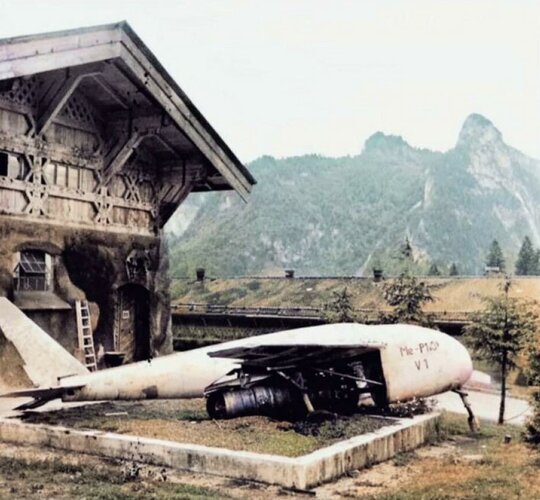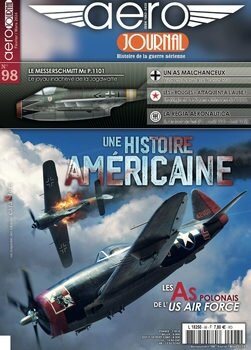My opinion
(s.jpg speculative drawing)
American crews had been trained to fly in self-defence bomber formations only a few meters apart from each other. The rules of air combat determined that an attacker fighter would not risk flying through such a compact formation, having to choose between shooting from far away and deviating at the last moment exposing their ventral surfaces to the powerful defensive crossfire of American gunners, who were considered statistically lethal from a range of one thousand yards.
A lonely fighter attacking a 'box' got in the gunsight of as many as 40 Browning M2 heavy machine guns. The Germans tried many different Pulkzerstörer (formation destroyer) tactics to break the ‘boxes’ without having to get too close. The four engine bombers, which they called Viermots or Dicke Autos, were attacked from a range of 1,800 m by Messerschmitt Me 410 A-2/U4 heavy fighters, fitted with Rheinmetall-Borsig BK.5 cannons of 50-mm that capable of dismantling a B-17 with a single hit. But they were so heavy that prevented the Me 410s could escape the P-51 Mustang escort fighters.
The Viermots were attacked from 1,300 m with W.Gr.21 rockets of 210 mm, launched from specially modified aircraft Messerschmitt Bf 110 G-2/R3, Focke-Wulf Fw 190 A-7/R6 and Messerschmitt Bf 109 G-6/R2. However, this type of spin-stabilised rocket was very inaccurate and, after the attack, the launcher plane could not release the launch tubes on flight, which considerably diminished its speed.
From 900 m range, some Junkers Ju 88 P-2 and Messerschmitt Bf 110 G-2/R1 fired their Rheinmetall-Borsig 'Flak 38' of 37-mm, an anti-tank canon with a low rate of fire that was too heavy to be installed on a single seat fighter and which use in air-to-air mode was a failure.
BK 3.7 (37-mm) cannon technical data
Developed from the Flak 18 cannon.
Ammunition (anti-tank): Wolfram-core Hartkern-Pzgr. L’spur 113-2201 in two coupled magazines with 6 rounds each.
Ammunition (anti-aircraft): Stielgranate 42 HEAT spigot M-Pzgr. 113-2202 in rotary magazine holding twenty-one rounds.
Weight: 272 kg. Rate of fire: 140 rpm. Muzzle velocity: 795-860 m/s.
Mounted in Messerschmitt Bf 110 G-2/R1, Junkers Ju 88 P-2/P-3/P-4 and Henschel Hs 129 B-2.
The Luftwaffe also tested various air-to-air bombing techniques in the summer of 1943, using Messerschmitt Bf 109 G-4 fighters that flew at 1,000 m over the ‘stream bombers’ throwing AB 50 containers, each one loaded with 34 standard infantry fragmentation grenades. The Focke-Wulf Fw 190 A-4/U3 of the I./JG1 launched SC 250 bombs and AB 500 containers (loaded with 370 kg of H.E. and fitted with time fuses) over the 'boxes' without achieving success.
At the beginning of 1944 there were already designs and prototypes of air-to-air missiles created to solve the 'thousand yards problem', but until they reached service status, the Luftwaffe was forced to fight the Viermots using Sturm (assault) fighter units specialized in schnauze auf schnauze (frontal attacks) combat. The advantage of a head-on pass was that the fighter remained only 5 seconds in the thousand yards area and took it another 9 seconds to cross the 'box', if it was lucky enough to not collide against any bomber. The downside was that the aircraft crossed so quickly that the fighter barely had time to fire. And to shoot down a Viermot were needed many shots!
The casualties of the Sturm units were terrible and increased even more when the America heavy bombers began to be escorted by large groups of long-range fighters.
From September 1944, it became necessary to increase the armour of the fighters transforming them into a new type of airplane called Sturmböck (assault rammer).
The extra armour was primarily in front for protection during the assault pass but the fighter was vulnerable to attack from the rear. In November 1944 the armour of a Sturmböck weighed 256 kg, making it a 25 per cent heavier than the Fw 190 series and a sure prey in dogfight for the Mustangs.
In early 1944, the technological superiority achieved by the allies already allowed them to interfere German radio control systems. This particularly affected the development programs of antiaircraft missiles Enzian, Schmetterling, Feuerlilie and Rheintochter in a stage of the war when German fighters were unable to contain the offensive, the Me 262 proved to be a poor dogfighter against the allied fighters and the Komet killed more German pilots than the enemy.
At this time, the aircraft needed by the Jagdwaffe was a powerful Zerstörer armed with long-range cannons and powered by turbojets that would allow it to elude enemy fighters.
On January 10, 1945 Hitler proposed to Göring that a 50-mm anti-tank cannon be fitted to the Arado Ar 234 jet bomber.
The Luftwaffe was already using Rheinmetall-Borsig BK 5 (Bord Kanone) automatic cannons mounted in Messerschmitt Me 410 A-2/U4 heavy fighters.
The 50-mm BK 5 was a very powerful weapon capable of disintegrating any Allied aircraft with a single shot.
Its great range would allow attacks on well defended formations of US bombers while the fighter remained a healthy distance from the defensive crossfire of American gunners, although the excessive weight of the cannon prevented the Me 410 from escaping the escort fighters.
Between February and April 1944, the 53 Me 410s of II./ZG 26 achieved some successes against the B-17 and B-24 heavy bombers, but nine fighters were shot down by the escorts P-51 D in a single day and the Gruppe was disbanded.
Unfortunately for the Germans, the powerful recoil of the available heavy cannons caused structural damage to single-engine fighters and large aircraft of the Ju 88, Do 217 and Me 410 types were not fast enough.
BK 5 (50-mm) cannon technical data
Developed from the KWK 391 anti-tank cannon.
Ammunition: 22 rounds belt-fed 50 x 419 R.
Pneumatic operation system.
Weight: 520 kg. Length: 3.79 m. Rate of fire: 45-50 rpm.
Mounted in Me 410 A-2/U4, Ju 88 P-1, Ju 288 and He 177.
To carry out Hitler's order, the OKL preferred to use the new 50-mm cannon Mauser MK 214 A (Maschinen Kanone), which weighed 50 kg less than the BK 5 and tripled its rate of fire.
To test the concept, two Messerschmitt Me 262 jet fighters (Werk. Nr. 111899 and 170083) were modified as Me 262 A-1a/U4, with the only two nose mounted MK 214 prototypes available.
Between 20 February and 23 March 1945, the first modified aircraft flew several test flights and two operational missions, without good results.
Production of the operational version of the Me 262 E-1 was dropped in favor of the Ruhrstahl-Kramer X-4 air-to-air guided missile that was already in the testing phase installed on the Me 262 Werk. Nr. 111994.
Also cancelled were the ground attack aircraft Arado Ar 234 C-3/R4 and the high-altitude heavy fighter Ar 234 D-3, which were to use an MK 214 A housed in the ventral nacelle.
The development of this cannon was only completed in March 1945 and the war in Europe was over before series production could get under way.
MK 214A (50-mm) cannon technical data
Developed from the PaK 38 anti-tank cannon
Ammunition: Belt-fed 50 x 419 R.
Panzergranate 40 armor piercing. Sprenggranate L-spur explosive. Minengesschos L-spur m-zerleger.
Weight: 490 kg. Length: 4.16 m. Muzzle velocity: 920 m/sec. Rate of fire: 150 rpm.
The Rheinmetall-Borsig MK 112/55 heavy cannon of the short range/fast firing class, was a scaled-up version of the MK 108/30 standard. The type weighed 300 kg, only fifteen prototypes were built but none was used in combat.
MK 112 (55-mm) cannon technical data
Weight: 300 kg. Length: 2 m. Muzzle velocity: 594 m/sec. Rate of fire: 300 rpm.
Ammunition: Belt-fed 55 x 175 RB
Between the end of May and the beginning of June 1944, Messerschmitt proposed to the OKL the construction of various types of heavy fighters, armed with 55 and 75-mm cannons. In order to compete for the new HeS 011 turbojets associated with the Jägernotprogramm, these designs were given project number P 1101.
The P 1101 (Drawing XVIII-92) of May 1944 was a two-seat, with 50-degrees swept wings and “V” tail, powered by two HeS 011 turbojets.
Messerschmitt P 1101-92 technical data
Wingspan: 13.28 m. Length: 13.10 m. Height: 4.10 m. Wing Area: 35 sq. m. Max Speed: 900 km/h. Power Plant: two wing-mounted HeS 011 turbojets each rated at 1,300 kg static thrust. Armament: one nose mounted Rheinmetall Borsig BK 7.5 anti-tank cannon with 12 shot rotating magazine and Zielfenrohr 4x telescopic gunsight.
BK 7.5 (75-mm) cannon technical data
Developed from the PaK 40 anti-tank cannon
Ammunition: drum-fed 75 x 714 R.
Weight: 705 kg. Length: 10.5 m. Muzzle velocity: 705 m/sec. Rate of fire: 30-35 rpm.
The P 1101 (Drawing XVIII-99) of June 6, 1944 was a two-seat Zerstörer, with 45-degrees swept wings and tail, powered by four HeS 011 turbojets.
P 1101-99 technical data
Wingspan: 15.20 m. Length: 15.40 m. Height: 4.90 m. Wing Area: 47 sq. m. Max Weight: 18,600 kg. Max Speed: 960 km/h. Power Plant: four wing-mounted HeS 011 turbojets each rated at 1,300 kg static thrust. Armament: one nose mounted Rheinmetall Borsig BK 7.5 anti-tank cannon with 12 shot rotating magazine and Zielfenrohr 4x telescopic gunsight, one 55-mm Rheinmetall Borsig MK 112 cannon mounted in the starboard wing root and four MK 112 cannons mounted in the fuselage in Schräge Musik configuration.
The Rheinmetall-Borsig MK 112 cannon was basically a scaled-up MK 108 with 300 rpm and 275 kg weight. Used by the Fw 190 A-8 works no. 170002 as suicide ramming aircraft prototype for the Selbstopfermänner units.
The P 1101 (Drawing XVIII-104) of June 1, 1944 was a two-seat Zerstörer, with 50/37-degrees cranked swept wings and “V” tail, powered by four HeS 011 turbojets.
P 1101-104 technical data
Wingspan: 17.35 m. Length: 18.10 m. Height: 4.10 m. Max Speed: 860 km/h. Power Plant: four wing-mounted HeS 011 turbojets each rated at 1,300 kg static thrust. Armament: one nose mounted Rheinmetall Borsig BK 7.5 anti-tank cannon with 12 shot rotating magazine and Zielfenrohr 4x telescopic gunsight, three nose mounted 30-mm Rheinmetall Borsig MK 108 cannons, three fuselage mounted MK 108 cannons in Schräge Musik configuration and one rear-firing MK 108 cannon mounted in the tail barbette.

















